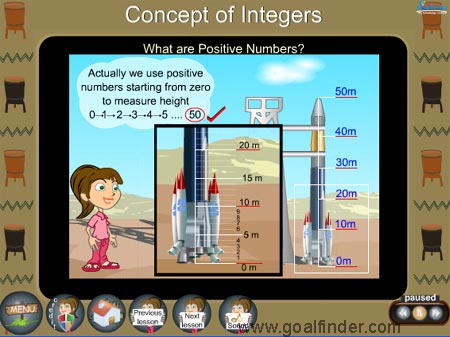
Image Source: http://www.goalfinder.com
An important skill is to be able to place positive and negative “integer” whole numbers into ascending and descending order.
Comparing Integers
A Number Line is very useful for working with directed number Integers.

Image Source: http://www.green-planet-solar-energy.com
On a number line, NUMBERS TO THE RIGHT ARE BIGGER.
NUMBERS TO THE LEFT ARE LESS THAN ones to the right.
For example: 6 is bigger than 3, but -6 is smaller than 3.
We say that 6 is greater than 3, and we write this as 6 > 3
However, -6 is less than 3, and we write this as -6 < 3

Image Source: http://elgee18.files.wordpress.com
Using Inequality Signs
> means greater than, or bigger than
< means less than, or smaller than. ( less than points to the left )
For the “inequality signs” < and >
THE POINTY ARROW ALWAYS POINTS TO THE SMALLER NUMBER.
Eg. 2 < 4, 8 > 5, -4 < -1, -2 > -6
The Fish Rule
Some people also like to think of the arrow sign as looking like the mouth of a fish.

Image Source: http://illuminations.nctm.org
They then use the following rule:
“The hungry Fish always wants to eat the bigger amount”.
So the open “<” mouth of the fish always goes towards the bigger item.

Image Source: http://illuminations.nctm.org
Placing Inequality Signs Rules
When putting a < or > sign in between two integers:
If the first number is more to the right, put a > sign.
If the first number is more to the left, put a < sign.
This will ensure that the arrow always points to the smaller number.
Remember to use a number line, ( especially for negative numbers ), and that :
NUMBERS TO THE RIGHT ARE BIGGER.
NUMBERS TO THE LEFT ARE SMALLER.
THE POINTY ARROW ALWAYS POINTS TO THE SMALLER NUMBER.
Represent Order and Compare Integers
The following is a video about comparing Integers, eg. Greater Than and Less Than, and placing Integers into ascending order.
It has no soundtrack, but has good slides.
The one limitation is that we cannot go full screen.
Click on the image below to go to the web page containing this video.
Using a Number Line to Order Integers
The following video from “School Tube” gives two examples of plotting Integers onto a Number Line.
We can then write the Integers out from left to right, which gives us their order from lowest to highest.
Click anywhere on the video below to launch the video full screen in a new window.
Here is another video about ordering and comparing integers using signs.
[youtube http://www.youtube.com/watch?v=m3oOpSBAeGI&w=540&h=304]
Ordering Integers Worksheet
The clickable link below is to a PDF document which gives you practice questions to do, as well as an answer sheet.
Click here for Ordering Integers Worksheet
Ordering Integers Game
In the following game, use the mouse to place the three red integer numbers in order, onto the carriages and the train engine.
The biggest number always goes onto the steam engine.
It is very important to place the numbers exactly in the middle of the carriages and engine like this:
If your answer is correct, the train should move to the right and off the screen.
Click anywhere on the image below to launch the game in a new window.
Note that you will probably have to page down the screen a bit to get to the actual game.
Ordering Integers Online Test
The clickable link below will take you to a web page from “Maths Goodies” that has a lesson you can read, followed by a short online test.
Click here to do Integers Online Quiz
Related Items
Introduction to Integers
Adding Integers Using Number Lines
Adding Integers Using Zero Pairs
Subtracting Integers
Multiplying Integers
Dividing Integers
Integers Order of Operations
Directed Number Integers Games
Integers in the Real World
Integers in Drag Racing
If you enjoyed this post, why not get a free subscription to our website.
You can then receive notifications of new pages directly to your email address.
Go to the subscribe area on the right hand sidebar, fill in your email address and then click the “Subscribe” button.
To find out exactly how free subscription works, click the following link:
If you would like to submit an idea for an article, or be a guest writer on our blog, then please email us at the hotmail address shown in the right hand side bar of this page.
Enjoy,
Passy








































